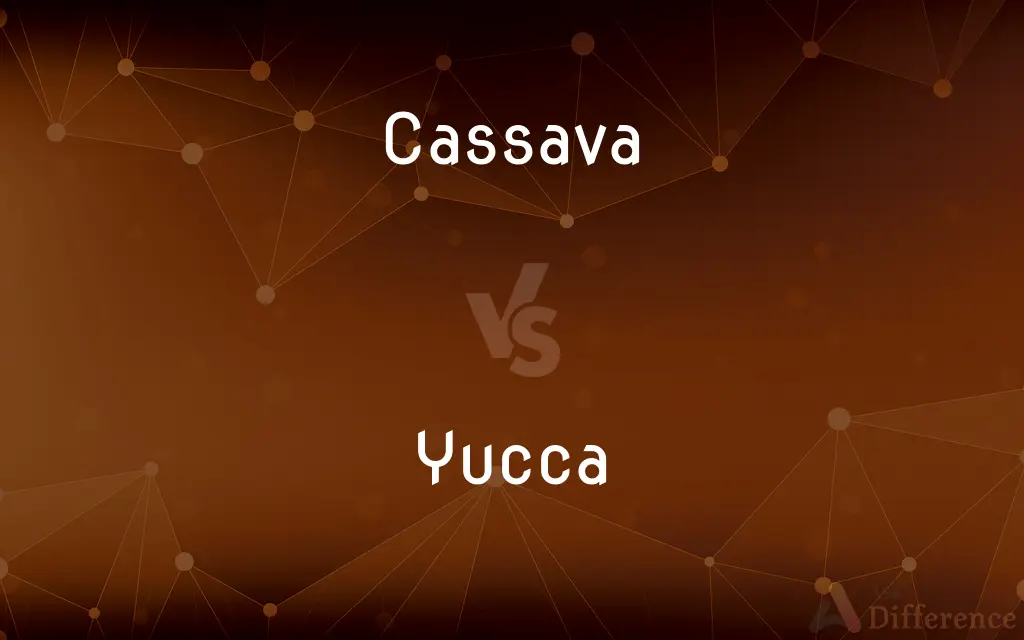Cassava vs. Yucca — What's the Difference?
By Tayyaba Rehman & Maham Liaqat — Updated on March 14, 2024
Cassava is a starchy root vegetable widely used in tropical regions, while yucca is an ornamental plant with edible parts, found in arid climates.

Difference Between Cassava and Yucca
Table of Contents
ADVERTISEMENT
Key Differences
Cassava is a tropical root vegetable known for its edible, starchy tuber, which is a major source of carbohydrates in many parts of the world, particularly in Africa, South America, and Asia. It's cultivated for its highly nutritious roots, which must be properly cooked to neutralize toxins present in raw form. Yucca, on the other hand, refers to a group of shrubby plants native to the drier parts of the Americas. It's recognized for its tough, sword-shaped leaves and striking clusters of white flowers. Some species of yucca produce edible parts, including flowers, fruits, and stems, but it's not primarily grown for food.
Cassava can be processed into various forms, including tapioca and flour, making it a versatile ingredient in cooking and baking. Instead, yucca is often valued for its ornamental qualities, as well as the fibrous material in its leaves, which can be used for making ropes and textiles.
While cassava roots are a staple food in many tropical countries, providing a significant portion of dietary energy needs, yucca plants are more commonly integrated into landscapes for their aesthetic appeal and drought resistance. Both plants require specific processing or preparation methods to be safe for consumption, as certain parts of yucca are also toxic if eaten raw.
Despite their similar names, cassava and yucca serve different purposes and occupy unique niches in their respective environments. Cassava is integral to food security in many developing countries, whereas yucca's role is more aligned with environmental landscaping and the production of non-food products.
The confusion between cassava and yucca often arises from their similar sounding names and the fact that both are associated with underground parts that can be eaten. However, their botanical families, uses, and cultural significance are distinct, highlighting the importance of understanding the specific characteristics and applications of each plant.
ADVERTISEMENT
Comparison Chart
Primary Use
Food source (roots)
Ornamental, some edible parts
Climate
Tropical
Arid, semi-arid
Edible Parts
Roots
Flowers, fruits, stems
Nutritional Value
High in carbohydrates
Varied, less significant as food
Preparation Required
Yes, to remove toxins
Yes, for edible parts
Cultural Significance
Staple food in many countries
Ornamental, some cultural uses
Toxicity
Raw roots contain cyanogenic glycosides
Some parts are toxic if not processed
Compare with Definitions
Cassava
Known for its drought tolerance and high starch content.
In many countries, cassava roots are boiled or fried as a staple dish.
Yucca
Leaves can be used to make ropes and textiles.
The fibrous leaves of yucca have been traditionally used to make durable ropes.
Cassava
Requires careful preparation to remove toxins.
Cassava must be soaked and cooked to ensure it is safe for consumption.
Yucca
Known for its drought resistance and low water requirement.
Yucca is an ideal plant for xeriscaping in arid regions.
Cassava
A tropical plant with an edible root that is a major carbohydrate source.
Cassava flour is a popular gluten-free alternative to wheat flour.
Yucca
An ornamental plant with sword-shaped leaves and white flowers.
Yucca plants are commonly used in dry landscapes for their aesthetic appeal.
Cassava
Can be processed into tapioca.
Tapioca pearls, used in bubble tea, are made from cassava.
Yucca
Some species have edible parts, including flowers and fruits.
Yucca flowers are sometimes eaten in salads or as a garnish.
Cassava
A crucial food security crop in developing countries.
Cassava cultivation supports the livelihoods of millions of farmers.
Yucca
Not a primary food source but has edible applications.
The fruits of some yucca species can be cooked and eaten.
Cassava
Manihot esculenta, commonly called cassava (), manioc, or yuca (among numerous regional names) is a woody shrub native to South America of the spurge family, Euphorbiaceae. Although a perennial plant, cassava is extensively cultivated as an annual crop in tropical and subtropical regions for its edible starchy tuberous root, a major source of carbohydrates.
Yucca
Yucca is a genus of perennial shrubs and trees in the family Asparagaceae, subfamily Agavoideae. Its 40–50 species are notable for their rosettes of evergreen, tough, sword-shaped leaves and large terminal panicles of white or whitish flowers.
Cassava
The starchy tuberous root of a tropical tree, used as food in tropical countries.
Yucca
Any of various evergreen plants of the genera Yucca and Hesperoyucca of the southern United States, Mexico, and Central America, having stiff sword-shaped leaves, clusters of white flowers, and sometimes a thick treelike stem.
Cassava
The shrubby tree from which cassava is obtained, native to tropical America and cultivated throughout the tropics.
Yucca
Any of several evergreen plants of the genus Yucca, having long, pointed, and rigid leaves at the top of a woody stem, and bearing a large panicle of showy white blossoms.
Cassava
A shrubby tropical American plant (Manihot esculenta) widely grown for its large, tuberous, starchy roots.
Yucca
The yuca (cassava).
Cassava
The root of this plant, eaten as a staple food in the tropics only after leaching and drying to remove cyanide. Cassava starch is also the source of tapioca. In both senses also called manioc, yuca.
Yucca
A genus of American liliaceous, sometimes arborescent, plants having long, pointed, and often rigid, leaves at the top of a more or less woody stem, and bearing a large panicle of showy white blossoms.
Cassava
Manioc (Manihot esculenta), a tropical plant which is the source of tapioca.
Yucca
Any of several evergreen plants of the genus Yucca having usually tall stout stems and a terminal cluster of white flowers; warmer regions of North America
Cassava
Tapioca, a starchy pulp made with manioc roots.
Cassava
A shrubby euphorbiaceous plant of the genus Manihot, with fleshy rootstocks yielding an edible starch; - called also manioc.
Cassava
A nutritious starch obtained from the rootstocks of the cassava plant, used as food and in making tapioca.
Cassava
A starch made by leaching and drying the root of the cassava plant; the source of tapioca; a staple food in the tropics
Cassava
Cassava root eaten as a staple food after drying and leaching; source of tapioca
Cassava
Any of several plants of the genus Manihot having fleshy roots yielding a nutritious starch
Common Curiosities
What is yucca?
Yucca is a genus of perennial shrubs and trees known for its ornamental value and some edible parts.
Is cassava flour the same as yucca flour?
Cassava flour is made from the root of the cassava plant, while "yucca flour" is a common misnomer for cassava flour; true yucca does not typically produce a food-grade flour.
What is cassava?
Cassava is a tropical root vegetable, cultivated for its edible, starchy tuber.
Can you eat yucca the same way as cassava?
No, yucca and cassava are prepared and consumed differently due to their distinct nutritional profiles and toxicity levels.
What are the main differences between cassava and yucca?
Cassava is primarily a food crop, while yucca is ornamental with some edible species.
How do you safely prepare cassava?
Cassava must be peeled, soaked, and cooked thoroughly to remove toxins.
Can eating raw yucca be harmful?
Yes, certain parts of the yucca plant can be toxic if not properly processed.
Why is cassava important in some countries?
Cassava is a staple food that provides a significant portion of dietary carbohydrates, particularly in developing countries.
What parts of yucca are edible?
Flowers, fruits, and stems of certain yucca species can be eaten.
Are cassava and yucca related?
Although they may have similar names, they belong to different botanical families and have distinct uses.
Are cassava and yucca interchangeable in cooking?
No, because of their different culinary uses and preparation methods.
Is tapioca made from yucca?
No, tapioca is made from cassava, not yucca.
Why must cassava be cooked before eating?
To eliminate cyanogenic glycosides, which can produce cyanide.
What are the health benefits of eating cassava?
Cassava is a good energy source due to its high carbohydrate content, but it should be consumed as part of a balanced diet.
Do cassava and yucca grow in the same climate?
No, cassava thrives in tropical climates, whereas yucca prefers arid conditions.
Share Your Discovery

Previous Comparison
Ointment vs. Cream
Next Comparison
Noble vs. SublimeAuthor Spotlight
Written by
Tayyaba RehmanTayyaba Rehman is a distinguished writer, currently serving as a primary contributor to askdifference.com. As a researcher in semantics and etymology, Tayyaba's passion for the complexity of languages and their distinctions has found a perfect home on the platform. Tayyaba delves into the intricacies of language, distinguishing between commonly confused words and phrases, thereby providing clarity for readers worldwide.
Co-written by
Maham Liaqat















































